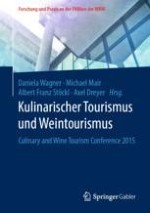2017 | OriginalPaper | Chapter
3. How important is “spiritourism” in France? An exploratory study/Welche Bedeutung hat „Spiritourismus“ für Frankreich? Eine explorative Studie
Authors : Laurence Cogan-Marie, Benoît Lecat, Cornelia Caseau, Claude Chapuis
Published in: Kulinarischer Tourismus und Weintourismus
Publisher: Springer Fachmedien Wiesbaden
Activate our intelligent search to find suitable subject content or patents.
Select sections of text to find matching patents with Artificial Intelligence. powered by
Select sections of text to find additional relevant content using AI-assisted search. powered by
